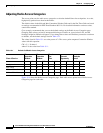
15-11
Cisco IOS Software Configuration Guide for Cisco Aironet Access Points
OL-29225-01
Chapter 15 Configuring QoS
Configuring QoS
IGMP Snooping
When Internet Group Membership Protocol (IGMP) snooping is enabled on a switch and a client roams
from one access point to another, the clients’ multicast session is dropped. When the access points’
IGMP snooping helper is enabled, the access point sends a general query to the wireless LAN, prompting
the client to send in an IGMP membership report. When the network infrastructure receives the host’s
IGMP membership report, it ensures delivery of that host’s multicast data stream.
The IGMP snooping helper is enabled by default. To disable it, browse to the QoS Policies - Advanced
page, select Disable, and click Apply.
Note If there is no multicast router for processing IGMP query and response from the host, it is mandatory
that no igmp snooping be configured on the access point. when IGMP snooping is enabled, all multicast
group traffic must send IGMP query and response packets. If IGMP query or response packets are not
detected, all multicast traffic for the group is dropped.
AVVID Priority Mapping
AVVID priority mapping maps Ethernet packets tagged as class of service 5 to class of service 6. This
feature enables the access point to apply the correct priority to voice packets for compatibility with Cisco
AVVID networks.
AVVID priority mapping is enabled by default. To disable it, browse to the QoS Policies - Advanced
page, select No for Map Ethernet Packets with CoS 5 to CoS 6, and click Apply.
WiFi Multimedia (WMM)
Using the Admission Control check boxes, you can enable WMM on the access point’s radio interface.
When you enable admission control, clients associated to the access point must complete the WMM
admission control procedure before they can use that access category.
Rate Limiting
Rate limiting provides control over the data traffic transmitted or received on an interface.The
Class-Based Policing feature performs the following functions:
• Limits the input or output transmission rate of a class of traffic based on user-defined criteria.
• Marks packets by setting the IP precedence value, IP differentiated services code point (DSCP)
value and Quality of Service (QoS) group.
This is used to rate-limit the upstream traffic originating from each of the non-roots to root bridge incase
of P2MP setup. To do rate-limiting on downstream traffic , class-maps are applied at the root-side
router/switch.
Note Rate-limiting can be applied to ethernet ingress only


















